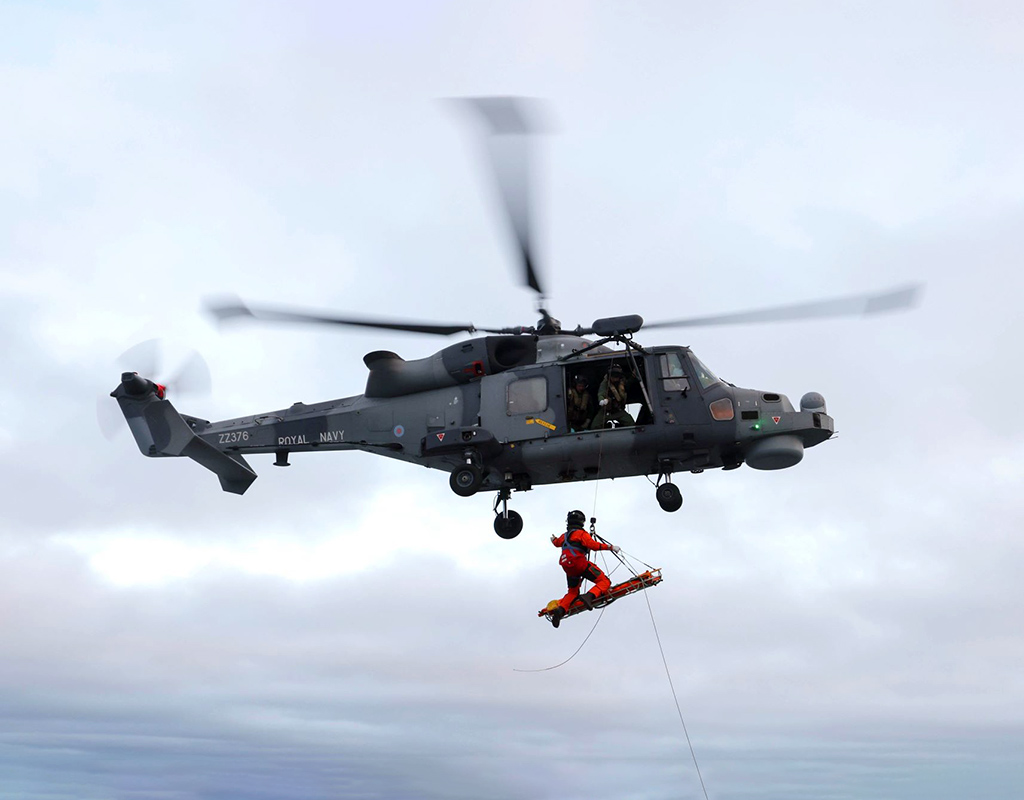
In a Humanitarian Aid and Disaster Relief (HADR) mission, time is of the essence – whether that’s a rapid reaction to rescue people, gaining situational awareness through reconnaissance, or through the delivery of vital first supplies, like water. The Royal Navy AW159 Wildcat HMA Mk2, from 815 Naval Air Squadron at RNAS Yeovilton in Somerset, is regularly forward deployed and therefore has been first on the scene when it comes to HADR missions worldwide, but particularly in the Caribbean and Bahamas regions. These regions have been vulnerable over the years to hurricanes and natural disasters where people have been stranded in remote locations.
Through training exercises and real-life scenarios, the Squadron operating the Wildcat flights has been available to support first-responders on the ground through the provision of water, situational awareness, and the transportation of casualties. The AW159 HMA Mk 2 Wildcat has often been the lead in collaborative efforts with allies, partners, NGOs, and governments in managing the response to HADR operations.
Maintaining a high readiness when at sea the aircraft’s 280 nm (nautical miles) range enables it to travel extended lengths from ship to shore to move personnel and materiel. The AW159 was designed from its inception as a multi-role naval helicopter with Ship Air Interface characteristics and compact dimensions that support small deck operations. With these features and its maximum cruise speed of 143 kt; the helicopter has the capability to act fast on the scene in support of HADR missions.
Cdr Alasdair Lang RN, Wildcat Maritime Force Commanding Officer, commented: “The aircraft is versatile like a Swiss army knife. Its advantage is it’s small and able to embark on a number of UK ships or allies’. [The Wildcat] is able to flit between roles [and] it has the most permissive envelope.”
Further to Hurricane Fiona, 815 Squadron played an integral role in September 2022 as part of rescue efforts in Turks and Caicos. The AW159 Wildcat was called upon to support isolated communities, with responders on the ground informing the crew that water was in demand. Disembarking from Royal Fleet Auxiliary (RFA) Tideforce, the Wildcat undertook numerous trips from ship to shore distributing fresh water.
The Flight Commander, Lt Cdr Phil Barron RN, explained the role of the AW159 Wildcat: “We were landing into non-prepared sites with minimal downwash – between first light to last light. We then recovered overnight and undertook the maintenance needed to clear the aircraft [for the next day].
“The comms relay on board the aircraft is very helpful because mobile phone masts generally have gone. [From the AW159 Wildcat], you can also get eyes on the situation to see where the damage is, if power lines are down, and if there’s any isolated communities, which helps prioritisation of the whole effort.”
Phil confirmed that working with those on the ground helps form a whole island chain of information to understand the scenario better. This is helped further by the aircraft’s on board camera by which information can be downloaded and shared with the relevant parties to make assessments on next steps and monitor the situation.
He said, “You often need to get to places that haven’t got prepared landing sites and the smaller and lighter [due to rotor downwash] you are the easier it is to get into a field or clearing – that’s a definite benefit of the 159. While some may consider ‘bigger is better’ the ability to recce, carry initial medical supplies and water for initial containment rapidly and frequently is by far more important in the initial stages.”
Phil noted that the aircraft was ‘well set’ for HADR missions due to its underslung load capability, which is only restricted by the size of the water barrels in the net. With the AW159 Wildcat’s large load capacity, it means fewer trips with supplies and there is capacity available to transport more.
With this aircraft designed from the outset to embark on ships, for the operator this means that there is no flight deck that cannot be flown from. Phil noted further that depending on the crew’s situation (e.g. ready in the aircraft or asleep on board with the aircraft stowed in the hangar) the AW159 Wildcat can be ready to fly within 45 minutes. In fact a fully operational flight and ship can get the aircraft airborne safely in even shorter time.
Apart from rapid response in a HADR scenario, like Hurricane Fiona, the AW159 Wildcat’s presence is a reassurance to those on the ground as it provides quick support with the distribution of fundamental necessities or through its situational awareness with its eyes above.
This press release was prepared and distributed by Leonardo UK.

